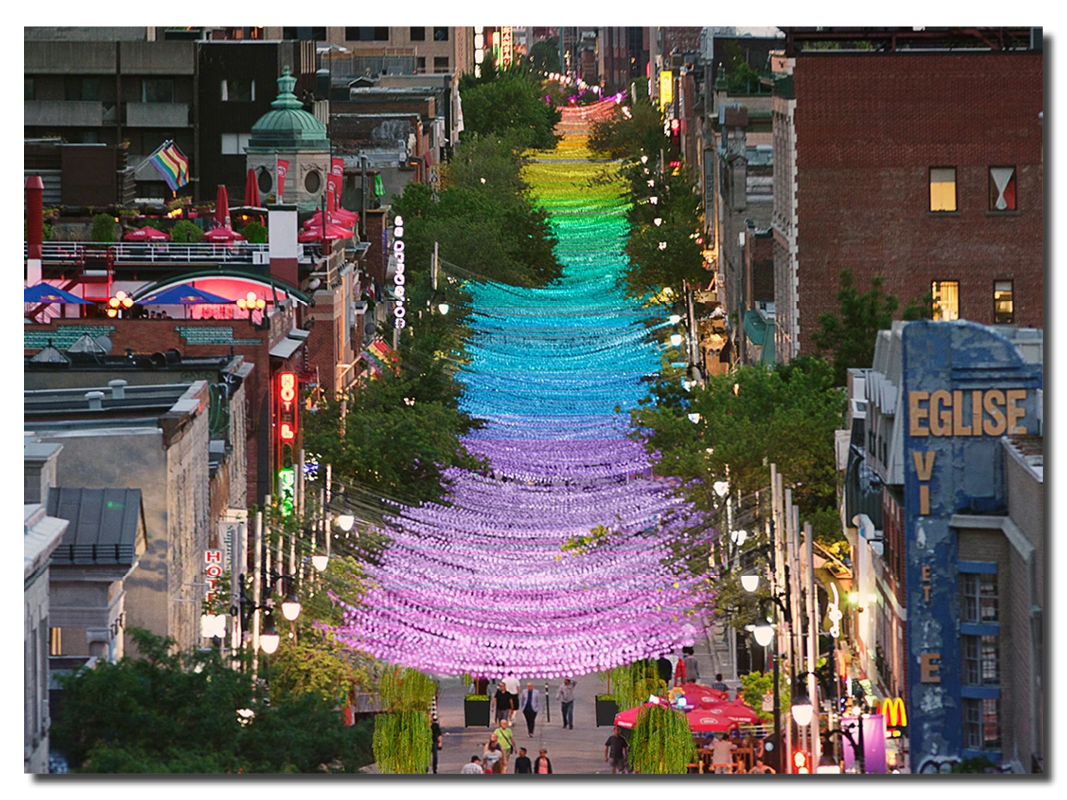
Quick Facts
Name
Pink Balls / 18 Shades of Gay
Type of Landscape
Cultural Landscape
Location
Montréal: Rue Sainte-Catherine East (between St-Hubert and Papineau streets)
45° 30' 36.46" N; -73° 33' 48.71" W
Legacy
Urban Renewal
Temporary/seasonal installation (no longer used)
Awards
Governor General's Medal in Landscape Architecture - Claude Cormier (2024)
Introduction

While most landscape architecture projects deal primarily with the ground plane, Pink Balls looked to the sky. The installation, composed of 170,000 pink balls strung over one kilometer of Rue Sainte-Catherine East, literally occupied the space above the street and sidewalk, creating a filigree canopy of pink light and shadow on the pedestrians below.
Commissioned as part of the Aires Libres event to revive Montréal’s LGBTQ2+ Gay Village, the Pink Balls project pushed the boundaries of urban landscape architecture. Installed during the six summer months between 2011 - 2016, Pink Balls represented an innovative study in colour by its landscape architect, Claude Cormier (1960-2023). Cormier echoed the “éspace propre” theory of French landscape architect, Bernard Lassus, by revealing how the hue of objects or plants can colour the spaces around them.
Cormier specified balls of two different sizes, elevating the amount of white in their coloring to produce a pink of high tonal value: intense and bright. Every ball was coated, their collective pinkness colouring the air as people looked down Sainte-Catherine East Street.

In 2017, to celebrate the City of Montréal’s 375th anniversary and the first edition Fierté Canada (launched by the National Association of Canadian Pride organizations), the Pink Balls concept was re-born as 18 Shades of Gay. Suspended on the same street, 180,000 resin balls referenced the first rainbow flag, designed by San Francisco’s LGBTQ2+ rights activist Gilbert Baker (1951-2017). Working with the original flag’s six colours, Cormier strengthened the balls’ ability to colour the air by increasing their tonal brightness in three levels. Since six times three shades equals eighteen, 18 Shades of Gay was born. Cormier also added 150 weeping willows in planters to the ground plane, to help cool the street in the hot summer months.
It Takes a Village…

For six years, the Pink Balls defined summer in the Montréal’s Gay Village. Given that each year’s installation was temporary, Cormier designed an overhead structural support system independent of the buildings lining either side of the street. As lead landscape architect, he coordinated a team of event rigging experts and lighting designers. The cables on which the balls were strung created a catenary curve, the ideal parabolic shape of a hanging chain or rope that drapes gracefully under its own weight when supported on two sides.
To string the pink balls onto cables, Claude Cormier engaged volunteers living and working in the neighbourhood. Cormier was known for his expertise in listening to members of the local community in any project, and by 2017, as the 18 Shades of Gay took shape, Cormier was involving locals in actual fabrication of the balls. While the pink balls had been made in China, Cormier found a Québec-based firm for the 18 shades of resin balls, who supplied unassembled half-balls with no mounting pins. Community volunteers assembled the 180,000 balls in three weeks, an intensive process that created a sense of agency among the participants.
We’ve Got Balls

Within its first few years, the Aires Libres’ Pink Balls event significantly revived Montréal’s LGBTQ2+ Gay Village. The vacancy rate for neighbourhood shops and restaurants dropped from twenty percent to just seven percent, reducing empty storefronts by more than a half. With motorized traffic banned here in summer months, foot traffic increased, bringing new customers.
Business success re-energized the neighbourhood. Social life in the quarter blossomed, with visitors and locals gravitating to the street to take delight in the filigree of pink over their heads. As William H. Whyte suggested in his Theory of Triangulation, the unique external stimulus connected people, stimulating conversation among strangers who would normally not talk to each other.
An artistic ripple effect inspired village artists to create other works in homage to Claude Cormier’s design. One artist installed a blue stairway to provide people with a view above the linear corridor of pink. Another crafted pink and black polka-dotted trash bags for all the shop owners to use, and the project inspired several short videos that pay tribute to both Pink Balls and later, 18 Shades of Gay.

By 2018, Tourisme Montréal had adopted 18 Shades of Gay for its marketing campaign, featuring aerial images of the project with markets in Toronto, New York City and throughout California. The slogan: “We've Got Balls. Come let your pride hang out.”
.png)

The Cultural Landscapes Legacy Collection highlights the achievements that have made a lasting impact within the field of landscape architecture and on communities across Canada.
